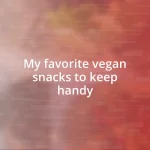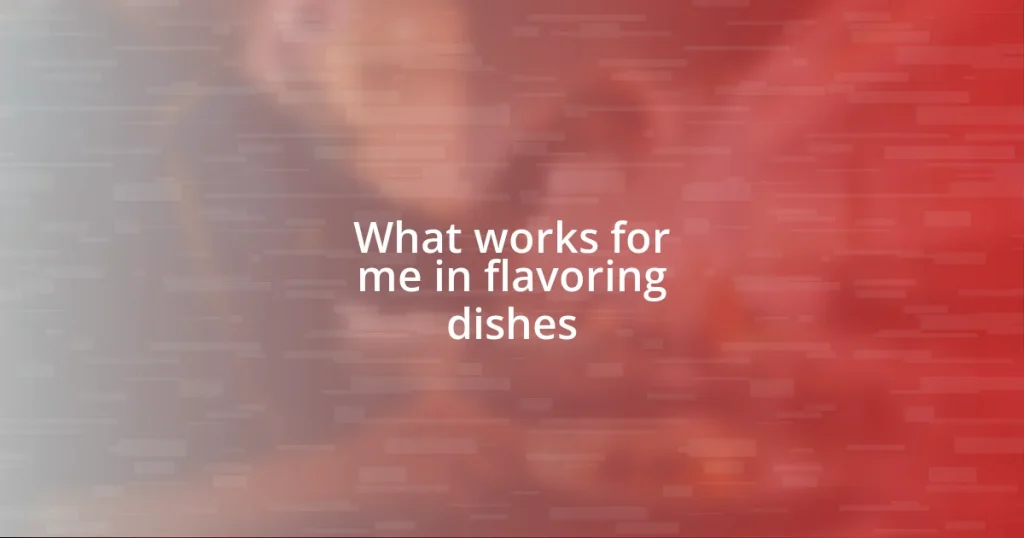Key takeaways:
- Understanding cravings involves recognizing emotional triggers, biological responses, and specific situations that lead to fast food urges.
- Setting realistic goals, such as incorporating healthier options gradually and rewarding progress, fosters a sustainable relationship with food.
- Developing mindful eating habits and planning meals ahead help prevent fast food consumption while enhancing appreciation for healthier choices.

Understanding fast food cravings
Cravings for fast food can hit unexpectedly, almost like a nostalgic pull to indulge. I remember sitting at my desk, overwhelmed by work, and suddenly finding myself daydreaming about a greasy burger and crispy fries. What is it about these foods that can summon such a strong reaction?
Emotionally, these cravings often stem from comfort and familiarity. I realized that during stressful times, I gravitated toward fast food not just for its taste, but for the emotional solace it provided. Does that resonate with you? It’s almost like a warm blanket on a cold night, but that temporary relief can lead to a longer-term struggle with choices.
Biologically, our bodies can also play a role in these cravings. The high sugar and fat content triggers a reward response in our brains, making us want more. Reflecting on my own experiences, I’ve found that knowing this helps me take a step back and consider whether I’m genuinely hungry or just responding to a fleeting mood.

Recognizing your triggers
When it comes to recognizing your triggers for fast food cravings, I’ve found that situational awareness is key. For me, certain environments or activities spark those cravings. For example, when I’m driving past my favorite fast-food joint, an overwhelming urge to stop can hit me out of nowhere. It’s fascinating how something as simple as a familiar location can pull at those strings of nostalgia and desire.
Additionally, emotional states play a significant role in cravings, something I’ve personally encountered during stressful periods. I’ll often find myself reaching for fast food when I’m feeling anxious or overwhelmed. It’s almost automatic—I see or think about food that promises comfort, and my body responds instinctively. By understanding that these feelings are often the culprits, I’m better equipped to address them without resorting to fast food.
Lastly, I’ve learned to pay attention to specific times of day when cravings typically arise. For me, afternoons seem to be the most challenging, especially around 3 p.m. That’s when I often find my energy dipping, and my mind starts wandering to thoughts about a quick meal. By identifying times when cravings are most likely to occur, I can develop strategies to counteract those impulses, like having a healthy snack on hand or taking a walk instead.
| Triggers | Examples |
|---|---|
| Situational | Driving by favorite fast food restaurant |
| Emotional | Feeling anxious or overwhelmed |
| Time of Day | Afternoon energy dips |

Setting realistic goals
Setting realistic goals is a crucial step in managing cravings effectively. I remember setting myself lofty expectations, thinking I could simply cut out fast food entirely. It didn’t take long for that plan to crumble, leaving me feeling defeated. Instead, I found that small, achievable goals work wonders. This not only makes the process feel manageable, but it also boosts my confidence as I reach each milestone.
To maintain balance and foster success, consider these guidelines for setting realistic goals:
- Start with one fast-food meal per week as a treat, rather than cutting it out altogether.
- Gradually increase your intake of healthier options, aiming for a balanced meal twice a week.
- Keep a food journal to track your cravings and emotions, which helps identify patterns and triggers.
- Reward yourself for progress, even if it’s just sharing your achievements with a friend.
- Be patient and forgiving with yourself. Understand that cravings are a natural part of the journey.
By focusing on tangible goals and remembering that progress takes time, I’ve discovered a healthier relationship with food that feels sustainable. Each small change leads me closer to my overall health objectives, without the stress of overwhelming my system.

Planning your meals ahead
Planning your meals ahead has been a game changer for me. I like to set aside some time each week to map out what I’m going to eat. During this planning, I notice that if I create a balanced menu that includes healthy snacks, I’m much less likely to stray into fast-food territory when cravings hit. Have you ever noticed how food choices feel easier when they’re laid out in front of you?
When I first started meal prepping, I would often feel overwhelmed by the sheer number of options in the grocery store. However, after making a list based on my planned meals, everything became clearer. I remember the sense of accomplishment I felt as I ticked off items on my list, knowing that I was building a foundation for healthier eating. It’s empowering to take control of my meals for the week ahead and not leave things to chance.
I’ve also come to appreciate the joy of cooking and experimenting with recipes. Occasionally, I’ll try to replicate my favorite fast-food items in a healthier way. For example, I once made a homemade version of crispy chicken tenders using oven-baked techniques. Not only was it satisfying to create a healthier alternative, but it also helped me feel fulfilled without the guilt that often accompanies fast food. Planning meals in advance isn’t just about discipline; it’s an opportunity to explore creativity and enjoy the process of nourishing my body.

Choosing healthier fast food options
When it comes to choosing healthier fast food options, I’ve learned the importance of scanning the menu for hidden gems. I remember dining at a popular chain and discovering a grilled chicken sandwich that was just as flavorful, yet significantly lighter than my usual double cheeseburger. It was a simple switch, but it made me feel good, knowing I was making a more nourishing choice while still enjoying fast food.
I often look for meals packed with vegetables, lean proteins, and whole grains. For instance, opting for a salad topped with grilled shrimp instead of fried chicken not only feels refreshing but also offers a satisfying crunch. Have you ever tasted something so satisfying that it completely shifted your cravings? By embracing these healthier alternatives, I’ve found myself feeling energized rather than weighed down after a meal.
Another strategy I employ is to share larger portions with friends or family. This way, I can enjoy the experience of fast food without overindulging in calories. I recall one evening out with friends, where we split a couple of different items. It not only enhanced our meal experience but also quenched my cravings without compromising my health goals. Why not make healthy choices a shared experience? It’s a fun way to enjoy fast food while prioritizing better options!

Developing mindful eating habits
Developing mindful eating habits has been a transformative journey for me. In the past, I often ate on autopilot, especially during fast-food runs. I recall one time driving through a familiar drive-thru, feeling the familiar pull of cravings, yet deciding to pause and reflect. By taking a moment to breathe and assess what I truly wanted, I found that I wasn’t genuinely hungry—it was more about habit than need. Have you ever felt like you ate just because it was there? By being mindful, I learned to recognize those moments and make intentional choices.
One useful technique I’ve adopted is focusing on my senses while eating. I remember a particular evening when I sat down to enjoy a simple meal. Instead of scrolling through my phone or zoning out to the TV, I took the time to appreciate the colors, aromas, and textures on my plate. I found this practice made each bite feel more satisfying. It’s fascinating how fully engaging with the experience of eating can reduce cravings. What if you tried savoring your meals more? You might discover a newfound appreciation for food that doesn’t continually draw you back to fast-food temptations.
Incorporating small rituals has also helped me cultivate mindfulness. For instance, I like lighting a candle before meals, creating a peaceful ambiance that encourages me to slow down. I remember a day when I made a point to enjoy my food without distractions—the simple act of focusing on the flavors and my environment made my meal feel richer and more fulfilling. This approach has taught me that eating should be an experience, not just a necessity. Have you thought about adding simple rituals to your meals? These can enhance your eating moments and shift your focus away from cravings.

Rewarding yourself for progress
Rewarding yourself for progress has been a game changer for me on this journey to manage my cravings at fast food. I remember the sense of pride I felt when I chose a lighter option instead of my usual guilty pleasure; I treated myself to a small dessert afterward. It wasn’t just about the sweet— it was a moment to celebrate a conscious choice I made, reinforcing my commitment to healthier habits.
I also find that setting milestones enhances the experience. For example, after a week of making better choices, I would plan a special outing with friends. During one such outing, we discovered a delightful little café that served delectable health-focused meals. The experience bonded us, and it built a positive association with my goals. Have you ever noticed how rewarding milestones can fuel your motivation? It’s like lighting a spark that helps you stay on track.
Sometimes, the rewards can be as simple as treating myself to a morning coffee from my favorite café after a week of victories. That little indulgence lifts my spirits and makes me feel like I’m investing in myself. When I sip that uplifting brew, it reminds me that my efforts are worthwhile, reinforcing the journey. Wouldn’t you agree that a small, enjoyable reward can make a big difference in sustaining your motivation? It’s those little joys that help to solidify my commitment to a healthier lifestyle.















